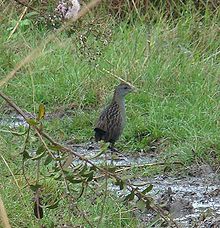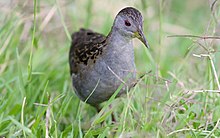
The russet-throated puffbird is a species of near-passerine bird in the family Bucconidae, the puffbirds, nunlets, and nunbirds. It is found in Colombia and Venezuela.

The sapphire-spangled emerald is a species of hummingbird in the "emeralds", tribe Trochilini of subfamily Trochilinae. It is regularly found in Bolivia, Brazil, Peru, and Venezuela; as a vagrant in Argentina; and has possibly occurred in Ecuador.

The greenish puffleg is a species of hummingbird in the "brilliants", tribe Heliantheini in subfamily Lesbiinae. It is found in Colombia, Ecuador, Panama, and Peru.

The chestnut-headed crake is a species of bird in subfamily Rallinae of family Rallidae, the rails, gallinules, and coots. It is found in Bolivia, Brazil, Colombia, Ecuador, and Peru.
Anurolimnas is a genus of birds that the South American Classification Committee of the American Ornithological Society and the Clements taxonomy apply to the chestnut-headed crake, the russet-crowned crake, and the black-banded crake. The International Ornithological Committee assigns the first two species to genus Rufirallus and the black-banded to genus Laterallus. BirdLife International's Handbook of the Birds of the World also places the first two in Rufirallus but assigns the black-banded to genus Porzana.
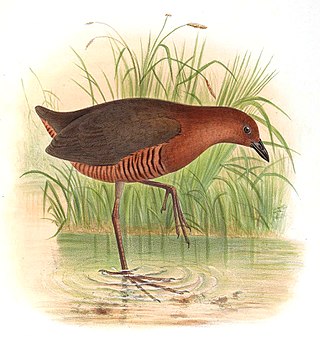
The black-banded crake is a species of bird in subfamily Rallinae of family Rallidae, the rails, gallinules, and coots. It is found in Brazil, Colombia, Ecuador, and Peru.
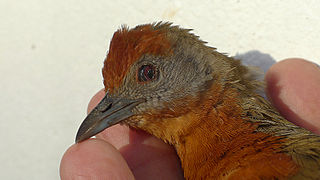
The russet-crowned crake is a species of bird in subfamily Rallinae of family Rallidae, the rails, gallinules, and coots. It is found in Bolivia, Brazil, Colombia, Ecuador, the Guianas, Paraguay, Peru, and Venezuela.
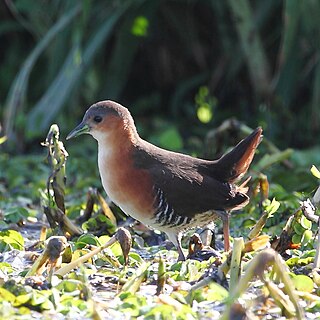
The rufous-sided crake is a species of bird in subfamily Rallinae of family Rallidae, the rails, gallinules, and coots. It is found in every mainland South American country except Chile.

The Colombian crake is a species of bird in the subfamily Rallinae of the rail, crake, and coot family Rallidae. It is found in Colombia, Ecuador, and Panama.

The paint-billed crake is a species of bird in the subfamily Rallinae of the rail, crake, and coot family Rallidae. It is found in Costa Rica, Panama, every mainland South American country except Chile and Uruguay, and the Galápagos Islands.

The yellow-breasted crake is a species of bird in subfamily Rallinae of family Rallidae, the rails, gallinules, and coots. It is found on several Caribbean islands and in most of Central America and South America.

The dot-winged crake is a vulnerable species of bird in subfamily Rallinae of family Rallidae, the rails, gallinules, and coots. It is found in Argentina, Brazil, Chile, and Uruguay.

The austral rail is a Vulnerable species of bird in subfamily Rallinae of family Rallidae, the rails, gallinules, and coots. It is found in Argentina and Chile.

Brigida's woodcreeper, also known as the Mato Grosso woodcreeper, is a subspecies of bird in the subfamily Dendrocolaptinae of the ovenbird family Furnariidae. It is endemic to Brazil.

The ocellated woodcreeper is a species of bird in the subfamily Dendrocolaptinae of the ovenbird family Furnariidae. It is found in Bolivia, Brazil, Colombia, Ecuador, Peru, and Venezuela.

The lettered aracari or lettered araçari is a near-passerine bird in the toucan family Ramphastidae. It is found in Bolivia, Brazil, Colombia, Ecuador, and Peru.

The Amazonian trogon, is a species of bird in the family Trogonidae, the trogons and quetzals. It is found in Bolivia, Brazil, Colombia, Ecuador, Peru, and Venezuela.

The white-throated toucanet or greyish-throated toucanet is a near-passerine bird in the toucan family Ramphastidae. It is found in Colombia, Ecuador, and Venezuela.

The white-throated daggerbill, white-throated wedgebill, or western wedge-billed hummingbird is a species of hummingbird in the family Trochilidae. It is found in Colombia and Ecuador.

The butterfly coquette is a species of hummingbird in the "coquettes", tribe Lesbiini of subfamily Lesbiinae. It is found in Bolivia, Brazil, Colombia, Ecuador, Peru, and Venezuela.
